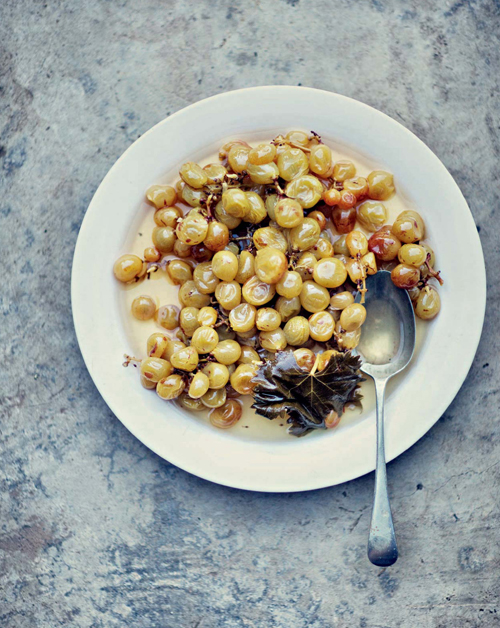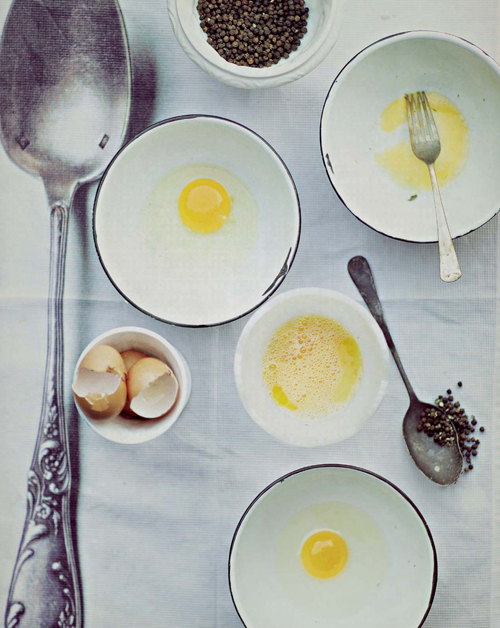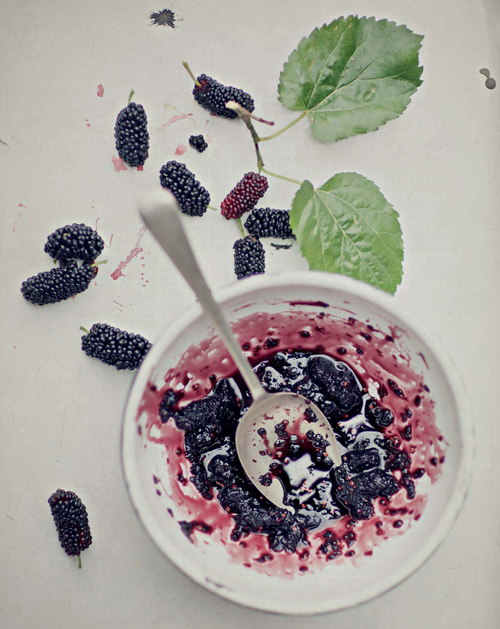SUGAR & SPICE
and all things nice …

QUINCE PRESERVE
Makes 2–3 medium jars
- 4–5 large quinces (1 kg)
- Granulated sugar
- 1 cup water
- Pinch citric acid
- Clean the quinces by rubbing the fruit to remove any fuzz from the surface. Quarter and remove the core, but do not peel. Now cut the quarters into 5 mm-thick slices. Weigh the quinces – there should be a 1:1 ratio with the sugar. Place the quinces in a wide, heavy-based saucepan. Evenly distribute the sugar over the quinces and pour in the water. Simmer on medium heat, uncovered, stirring with a wooden spoon from time to time until the quinces are golden and the syrup has thickened somewhat. This will take 50–60 minutes. Add the citric acid 5 minutes before removing from the heat. Allow to cool. Spoon into sterilised jars and seal tightly. Keep in a cool, dry place.
WHOLE GREEN FIG PRESERVE
Makes 6–8 medium jars
- 2.5 kg fresh green figs
- Bicarbonate of soda
- 1 cup sugar
- Whole cloves
- Cinnamon sticks
- Fresh ginger
- Fresh lemons
- Make sure the figs are swollen and not hollow inside. Thinly peel the skin off and make a cut in the shape of a cross at the bottom end of each fig. Stand overnight in a mixture of bicarbonate of soda (2 teaspoons bicarb to every 2 cups water). This will help to preserve the green colour of the figs. Wash and then cook the figs in boiling water until they are soft. This will take about 30 minutes. Now place the figs in a boiling syrup of 3 cups water and 1 cup sugar. Add a few cloves, cinnamon sticks and slices of fresh ginger. Add the juice of 1 lemon to every 2.5 kg figs. Boil for about 2 hours until the syrup is thick and the figs are translucent. Place in sterilised jars.
BASIC PASTA DOUGH
Makes 500 g
- 500 g cake flour
- 1 teaspoon salt
- 2 large eggs
- 8 large egg yolks
- 1 tablespoon olive oil
- Combine the flour and salt in a food processor. Process until mixed well, then add the eggs, egg yolks and olive oil until it forms crumbs. This will take about 2 minutes. Take a large amount of dough at a time and press into a firm ball. Roll out the dough to the desired size or use a pasta machine according to the manufacturer’s instructions.

SAFFRON GUAVAS IN SYRUP PRESERVE

Makes 2–3 medium jars
- 6 guavas, washed and halved
- 2 cups water
- 2 cups sugar
- 6 whole cloves
- 1 piece stick cinnamon
- Pinch saffron
- Boil the guavas in the water until they become soft. Drain the water from the guavas and set them aside. Place the sugar, cloves, cinnamon stick and the saffron in a saucepan and boil until it forms a light syrup. Add a little water if needed. Add the guavas to the syrup, then spoon the guavas and syrup into sterilised jars and seal.
SALTED CARAMEL SAUCE
Makes 11/2 cups
- 1 cup sugar
- 1/4 cup water
- 3/4 cup double cream
- 4 tablespoons unsalted butter
- 1 teaspoon salt
- Mix the sugar and water in a heavy-based saucepan on medium heat. When the sugar has dissolved, turn up the heat and bring to a boil without stirring. Boil for about 5 minutes until the syrup is a dark amber colour. Remove the caramel from the heat and carefully whisk in the double cream. There will be a lot of bubbling and splashing. Now stir in the unsalted butter and salt. Stir gently to combine. Transfer to a dish and allow to cool slightly before using.
CRÈME FRAÎCHE–HONEY ICE CREAM
Serves 4
- 4 egg yolks
- 1/4 cup flower honey
- 1 teaspoon cornflour
- 11/4 cups low-fat milk
- 11/2 teaspoons pure vanilla extract
- Generous 1 cup crème fraîche
- Whisk the egg yolks, honey and cornflour in a bowl until thick and foamy. Pour the milk into a heavy-based saucepan, bring to a boil, then gradually pour onto the yolk mixture, whisking constantly. Return the mixture to the saucepan and cook on low heat, stirring constantly, until the custard thickens and is smooth. Pour the custard back into the bowl and then chill. Using an ice-cream maker, stir the vanilla and crème fraîche into the custard mix and churn until thick enough to scoop or as instructed by the manufacturer.
- Tip: Measure the honey carefully and use level spoonfuls. If you are overgenerous, the honey flavour will dominate the ice cream and it will be too sweet.
BLOODY MARY TOMATO RELISH

Makes 4 medium jars
- 2 red peppers, seeded and chopped
- 3 stalks celery, roughly chopped
- 2 large onions, roughly chopped
- 1 long red chilli, roughly chopped
- 1 kg very ripe tomatoes, chopped
- 2 tablespoons Worcestershire sauce
- 300 ml red wine vinegar
- 11/2 cups brown sugar
- 1 bay leaf
- 1/4 cup vodka
- Whizz the peppers, celery, onions, chilli and tomatoes in a food processor until finely chopped. Transfer to a large preserving pan and add the remaining ingredients, except the vodka. Heat gently, stirring until the sugar has dissolved. Turn up the heat until the mixture bubbles gently. Cook for 1–11/4 hours, stirring often until thick. It is ready when a spoon drawn through it leaves a trail without any liquid filling the gap. Stir in the vodka and spoon into a sterilised jar.
SPICED BRANDY AND APPLE CHUTNEY
Makes 4 medium jars
- 2 tablespoons sunflower oil
- 500 g onions, thinly sliced
- 2 teaspoons black peppercorns
- 1 kg mixed apples (a variety of sweet dessert and sour ones)
- 150 g sultanas
- 1 tablespoon thyme leaves
- 1/2 teaspoon ground allspice
- 1/2 nutmeg, freshly grated
- 400 g light brown sugar
- 350 ml cider vinegar
- 1/4 cup brandy
- Heat the oil in a large preserving pan, add the onions and cook on medium heat for 20–25 minutes until deep golden. Crush the peppercorns and add to the onions along with the remaining ingredients, except the brandy. Heat gently, stirring until the sugar has dissolved. Simmer for 30–40 minutes, stirring often until thick. To see if the chutney is cooked, scrape the bottom of the pan with a spoon; if any liquid runs back into the space, cook for a few more minutes. Set aside to cool for a few minutes, then stir in the brandy and spoon into sterilised jars.
EASY TEMPURA BATTER
Makes 11/2 cups
- 1 egg
- 1 cup iced water
- 3/4 cup cake flour
- Pinch bicarbonate of soda
- Beat the egg and water together until light and fluffy. Add the flour and bicarbonate of soda to the egg mixture and mix together quickly. Do not overmix. Use to coat vegetables, prawns and fish and deep-fry until golden.
BEETROOT AND ORANGE CHUTNEY
Makes 2 kg
- 1.5 kg raw beetroot, peeled and diced (wear gloves)
- 3 onions, chopped
- 3 apples, peeled and grated
- Zest and juice of 3 oranges
- 2 tablespoons mustard seeds
- 1 tablespoon coriander seeds
- 1 tablespoon ground cloves
- 1 tablespoon ground cinnamon
- 700 ml red wine vinegar
- 700 g granulated sugar
- Place all the ingredients in a large saucepan or a preserving pan and mix well. Bring to a gentle simmer and cook for 1 hour. Using a wooden spoon, stir until the chutney is thick and the beetroot cooked.
- Once the chutney is ready, allow to cool for about 15 minutes, then carefully spoon into sterilised jars and seal while it is still hot. You can use it straight away, but it will be even better within a month or two. The chutney will keep for up to six months.
GRAPES IN SPICY WINE SYRUP

Makes 3–4 medium jars
- 1 kg sweet white grapes
- 500 g granulated sugar
- 1/2 cup dry white wine
- 1/2 cup orange juice
- 1/2 cup water
- Pinch salt
- 1/2 vanilla bean
- 1/2 star anise
- 1 cardamom pod
- 1 whole clove
- 1 tablespoon lemon juice
- Place all the ingredients, except the lemon juice, in a large pot and bring to a boil for 15–20 minutes, stirring very gently occasionally. Remove from the heat, cover and let it stand overnight. Carefully remove the whole spices and boil for a further 40 minutes until the syrup thickens slightly. Stir in the lemon juice and turn off the heat. When the grapes have cooled to room temperature, you can add a few more cloves if you like. Place in sterilised jars and keep in the fridge.
CRÈME ANGLAISE (LIGHT POURING CUSTARD)
Makes 2 cups
- 1 cup full-cream milk
- 1 cup fresh cream
- 1 vanilla bean, split lengthwise
- 6 large egg yolks
- 1/2 cup castor sugar
- Bring the milk, cream and vanilla bean to a simmer in a saucepan. Remove from the heat and infuse for 15 minutes. Whisk the egg yolks and sugar in a bowl until light. Gradually whisk the hot milk mixture into the yolk mixture. Return the custard to the saucepan and stir on low heat for 5 minutes (do not boil) until thick. It should leave a path on the back of a spoon when a finger is drawn through it. Strain through a fine sieve.
AROMATIC VINEGAR
Delicious on salads, drizzled over fresh leaves and edible flowers, or lettuce and fines herbes salad.
Makes 4 cups
- 4 cups wine vinegar
- 2–3 cloves garlic, crushed
- 1 bay leaf
- 1 tablespoon mixed herbs
- 3 sage leaves
- 2 whole cloves
- 5 coriander seeds
- Reduce the vinegar by half on high heat. The fumes are strong so open windows and doors when doing this. Once reduced, remove from the heat and add all the remaining ingredients. Leave to cool overnight or for several hours. Strain through muslin cloth or funnel into a bottle.
FRENCH VINAIGRETTE
Makes 100 ml
- 1 anchovy
- 1 small clove garlic
- Pinch salt
- Juice from 1/2 lemon
- 1 teaspoon Dijon mustard
- 1/4 cup olive oil
- Freshly ground black pepper or small pinch piment d’Espelette
- In a mortar and pestle, mash the anchovy, garlic and salt to a paste. Squeeze in the lemon juice and stir to break up the anchovy paste. Beat in the mustard. Either beat or whisk in the olive oil, a few glugs at a time. The vinaigrette should emulsify, but will never become mayonnaise-like, and that’s okay. Season with the pepper or chilli. Wash some sturdy or bitter greens and you’re on your way to salad paradise.
CRÈME PÂTISSIÈRE (PASTRY CREAM)

Makes 2 cups
- 400 ml full-cream milk
- 1 vanilla bean, split lengthwise
- 4 egg yolks
- 80 g castor sugar
- 30 g cornflour
- 25 g butter, melted
- Bring the milk and vanilla bean to a simmer in a medium saucepan, but do not boil. Remove from the heat and leave to infuse for 10 minutes.
- In a bowl, whisk the egg yolks and castor sugar with the cornflour until it turns a lemony yellow. Take one ladle at a time of the warm milk and mix into the egg and sugar mixture. Once mixed, return to the saucepan on medium heat. Stir continuously until the custard thickens. Allow to boil for a few seconds, then remove from the heat. Mix the melted butter into the cream. To cool the pastry cream quickly, use a plastic ladle to spread the cream over a marble work surface. Once cooled, scrape back into the bowl and refrigerate for up to three days.
BRANDY SNAPS
Makes 48 biscuits
- 6 tablespoons unsalted butter, cubed
- 1/3 cup sugar
- 3 tablespoons golden syrup
- 2/3 cup cake flour
- 2 teaspoons brandy
- 1 teaspoon ground ginger
- Preheat the oven to 180 °C and line a baking tray. In a saucepan, combine the butter, sugar and golden syrup. Cook and stir on medium heat until the butter has melted. Remove from the heat and stir in the flour, brandy and ginger. Drop teaspoonfuls, three at a time, onto the prepared baking tray and bake for 7–8 minutes or until golden brown. Cool for 30 seconds. Working quickly, loosen each cookie and curl around a thick wooden spoon handle. Remove and place on a wire rack to cool completely. Fill with Chantilly cream or use as garnish on desserts.
BASIC TUILLE BISCUIT
Perfect for a dessert garnish or on its own with a dusting of icing sugar.
Makes 20–30 biscuits
- 125 g cake flour, sifted
- 125 g icing sugar
- 3 egg whites
- 80 g butter, melted
- Seeds of 1/2 vanilla bean
- Make a paste using the flour, icing sugar and egg whites. Add the melted butter and stir in the vanilla seeds. Cover and place in the fridge to set for approximately 30 minutes. Spread the paste on a greased baking tray by either using a stencil or with the back of a spoon. Bake in a preheated oven at 160 °C for 10–15 minutes, or until golden brown. Once cooked, remove and shape immediately. Store in an airtight container for up to three days.
SHORTBREAD
Makes 20–24 biscuits
- 1 cup cake flour
- 1/3 cup icing sugar
- 1/8 teaspoon salt
- 1/2 cup cold unsalted butter, diced
- A very easy way to make the shortbread crust is in a food processor. Place the flour, sugar and salt in the processor and combine. Add the butter and pulse until the pastry starts to come together and form lumps. Do not handle too much as this will affect the lightness of the pastry. Shape into a ball and cover with plastic wrap. Rest in the fridge at least 15 minutes before using. To bake, roll out the dough on a surface lightly dusted with flour, cut out biscuits and place on a baking tray. Bake for 15–20 minutes in a preheated oven at 190 °C.
PÂTÉ BRISÉE (SHORT CRUST PASTRY)
Makes 400 g
- 250 g cake flour
- 125 g butter, diced
- Pinch salt
- 1 egg yolk
- Cold water
- Place the flour on a work surface and add the butter on top. Sprinkle the salt over and, using your hands, crumble the butter and flour until it reaches the consistency of breadcrumbs. Make a well in the centre and add the egg yolk and a few teaspoons of cold water. Start mixing from the centre outwards until you have a manageable dough. Add water if necessary. Be careful not to overwork the pastry as this will affect its lightness. Make a ball and wrap in plastic wrap. Place in the fridge to rest for at least 30 minutes.
PÂTÉ SUCRÉE (SWEET PASTRY)
Makes 300 g
- 1/2 cup unsalted butter, room temperature
- 1/4 cup granulated white sugar
- 1 large egg
- 11/2 cups cake flour
- 1/8 teaspoon salt
- Mix the butter and sugar together until creamy and light. Add the egg and beat until just incorporated. Add the flour and salt and mix until it all comes together. Don’t overwork the pastry or it will be hard when baked. Flatten into a disc, cover with plastic wrap and refrigerate for about 1 hour, or until it is firm.
EASY PUFF PASTRY
The French call it pâté feuilletée, which means ‘pastry made leaf-like’. Each of these ‘leaves’ consists of a layer of flour separated by a layer of butter.
Makes 500 g
- 250 g cake flour
- Pinch salt
- 250 g unsalted butter, diced
- Sift the flour into a large bowl with a good pinch of salt. Add the butter to the flour and rub in using your hands. You should still be able to see chunks of butter. Make a well in the centre, add 100 ml cold water and combine. Add a little more water if necessary until you have a firm, rough dough. Roll out on a lightly floured surface into a rectangle. You should be able to see the streaks of butter in the pastry. Fold a third of the pastry into the centre, then fold the bottom third up over that. Give the dough a quarter turn and roll out again. Repeat folding, rolling and turning twice more. Chill the pastry for 30 minutes before using.
AUBERGINE PICKLE
Makes 4 medium jars
- 2 tablespoons sunflower oil
- 1 bulb garlic, cloves chopped
- 1 tablespoon cumin seeds, crushed
- 2 tablespoons coriander seeds, lightly crushed
- 2 red chillies, seeded and chopped
- 1 tablespoon flaked sea salt
- 1 kg aubergines, cut into 1 cm cubes
- 400 g light brown sugar
- 500 ml white wine vinegar
- Heat the oil in a large pan and add the garlic, spices, chillies, salt and aubergines. Cook for 15 minutes until the aubergines have shrunk by half. Add the sugar and vinegar, then boil for 30–40 minutes until there is no liquid left in the pan. Mash slightly and then spoon into sterilised jars.
SAUTÉED SOUR PLUM PICKLE
Makes 2–3 medium jars
- 20 sour/unripe plums
- 3 tablespoons peanut oil or any nut oil
- 1 teaspoon wholegrain mustard
- 3 whole red chillies, seeded and broken into pieces
- 1/4 teaspoon turmeric
- Pinch ground mustard seeds (optional)
- Salt
- 2 tablespoons chilli powder
- Wash the plums and dry completely. Heat the oil in a heavy-based pan on high heat. When the oil is hot, add the mustard. When the mustard starts to go brown, reduce the heat and add the chillies. When the chillies turn dark brown, add the turmeric and ground mustard, immediately followed by the sour plums. Sauté on medium heat, uncovered, until they become soft. Be careful not to overcook them. When the plums are soft, add salt and the chilli powder. Give it a good stir and cool completely before transferring to a dry, sterilised jar. Store in the fridge.
QUICK SWEET MUSTARD

Makes 2 cups
- 1 x 397 g can condensed milk
- 1/2 cup vinegar
- 1 tablespoon mustard powder
- 1/2 cup melted unsalted butter
- 2 egg yolks
- Pinch salt
- Mix all the ingredients in a bowl until combined and then transfer to a glass jar. Refrigerate for two days before use.
PEACH AND RASPBERRY JAM
Makes 4 medium jars
- 1 kg just-ripe peaches or nectarines, pitted and cut into large chunks
- 21/2 cups raspberries
- Juice of 2 lemons
- 900 g sugar or preserving sugar
- Place the peaches in a large pot with the raspberries and lemon juice. Cook gently for 15 minutes. Gently stir until softened, then remove from the heat and add the sugar. Stir well and heat gently until the sugar has dissolved. Bring to a rapid boil. Boil for 20 minutes, then test to see if the jam is setting. If not, boil for another 5 minutes and retest. Cool for 15 minutes so the fruit is evenly distributed, then spoon into sterilised jars.
- Tip: To test if setting point has been reached, put a plate in the freezer before you start. When the mixture smells like sweet fruit, remove from the heat, spoon 1 teaspoon onto the cold plate and push the jam with your finger. If the surface wrinkles, you have reached setting point.
MULBERRY JAM

Makes 2–3 medium jars
- 6 cups mulberries
- 41/2 cups sugar
- 1 tablespoon lemon zest
- 2 tablespoons lemon juice
- Wash and hull the mulberries, making sure to discard twigs, leaves and any blemished fruit. Place in a saucepan with the sugar, lemon zest and juice. Stir on low heat, boiling gently for 10 minutes or until the jam sets when tested (see tip above). The mixture should thicken by this stage. Skim the surface with a spoon to remove any sediment and then turn into a large bowl. Leave the jam to stand for about 8 hours (covered with a kitchen towel), stirring it from time to time to ensure that the berries are all mixed well with the juice. Pour into a sterilised jar and seal.
HOMEMADE LEMON CURD
Makes 2 cups
- 6 tablespoons unsalted butter, room temperature
- 1 cup granulated sugar
- 2 large eggs
- 2 large egg yolks
- 2/3 cup lemon juice
- 1 teaspoon lemon zest
- Beat the butter and sugar with an electric mixer for about 2 minutes, or until light. Slowly add the eggs and yolks. Beat for another minute. Mix in the lemon juice. The mixture will look curdled, but it will smooth as it cooks. Transfer the mixture to a heavy-based saucepan and cook on low heat until it starts to get smooth. The curdled appearance disappears as the butter in the mixture melts. Increase the heat to medium and stir continuously until thick. This will take about 15 minutes. Do not allow the mixture to boil. Remove from the heat and add the lemon zest. Transfer the curd to a bowl and place plastic wrap directly onto the surface to prevent a skin from forming. Chill in the fridge in an airtight container. It will keep in the fridge for up to one week.








